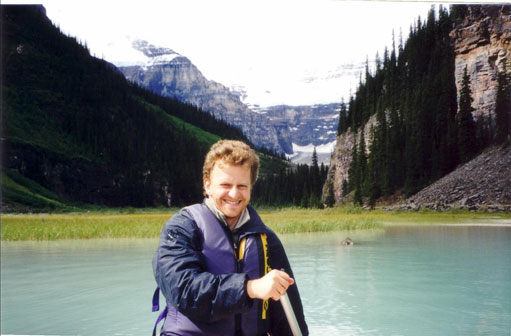Richard Teuscher
22 September 2009 | By

As an ATLAS physicist, it’s not often you get to stand back and look at the bigger picture, according to Richard Teuscher: “Not at all! It’s only really when you get a chance to talk to someone about what you’re doing. Day-to-day, you’re writing software or fixing some part of the detector. But at the end you think, ‘Wow, look what we’ve done!’”
This, then, is one of the reasons why Richard enjoys giving public lectures, where the very act of putting together a talk reminds him of the remarkable things that have been and will be achieved at ATLAS. His affiliation with the Canadian Institute of Particle Physics leaves him free to focus on research without the distraction of teaching, but he nevertheless makes it a priority to return to his institute – the University of Toronto – several times a year to give presentations.
The majority of Richard’s time has recently been spent with the Jet/ETMiss group, looking at the accuracy of the Liquid Argon (LAr) and Tile Calorimeters when measuring high-energy jets and missing transverse energy in ATLAS. When he arrived as a CERN Fellow in 1997, he was doing “exciting stuff” analysing LEP data on OPAL and hunting for signatures of the Higgs and new particles. His movements since then – to ATLAS with Chicago in 1999, and then with Toronto in 2006 – have been somewhat dictated by those of his fellow Canadians, he says.
“You still see people from OPAL on ATLAS today … people want to keep working together if they can” he explains, suggesting that the trust and mutual understanding that colleagues establish over time allows them to speak their minds without inhibition. “There’s some psychological aspect that you could study. It’s interesting how it works.”
Since 1999, Richard has worked on ATLAS both above and below ground, on electronics hardware, scaffolding, the Tile and LAr Calorimeters, and now jets and missing ET. “It’s kind of the fun part of the job though, you get to do so many different things,” he smiles. Including help with rescue missions occasionally…
“There was a very heavy wind storm in Geneva in the early days of installing the TileCal, and the wind actually bent some of the roof of the ATLAS surface building open,” Richard remembers. Although there were two levels of drainage protection, so much rain entered the building that these overflowed and water started falling down the access shaft and onto the newly-installed bottom half of the TileCal. “We got a very panicked call from the group leader saying, ‘Anyone who has access underground, come down now. And bring a towel!’”
Thankfully that drama ended well, and Richard went on to witness another of the TileCal’s most dramatic moments: being the first to register cosmic muons underground. It was actually the first data seen by any LHC experiment and even made it into Nature. Recalling the moment that the event display showed the first track across the TileCal, Richard says: “OK, it’s a small step, but it’s like a little baby crying for the first time,” expressing himself as only a parent could.
Indeed, Richard is a father of two: Julian, who is almost four, and four-month-old Valentina. As if juggling physics and a newborn weren’t already enough of a handful, Richard will take up the position of co-convenor of the Jet/ETMiss from next month. “My wife is very understanding,” he concedes of his busy spouse, who also works part-time. “Obviously, without her it doesn’t work.”
Richard met Martine, a Dutchwoman, in Hamburg – he was a grad student at DESY and she, an intern at a European Information Centre. After grad school they moved here with just two suitcases and a bicycle and began to build a life together.
Having a young family has meant that hobbies have had to take a bit of a backseat in recent years, but Richard is finding new ways to enjoy old pastimes. Having spent his pre-Hamburg life around the western end of Lake Ontario, he enjoys what he describes as “the usual stuff”: canoeing, cross-country skiing and hiking. As soon as Valentina is able to sit up, the family will be back out in the hills, with the baby enjoying the view from Richard’s back.
His previous passion for nature photography – a remnant of the artistic spirit that saw him have a solo drawing exhibition aged 16 – has also found new direction with the arrival of his two new muses. “Once you have kids, suddenly your photo collection increases dramatically,” he laughs.
Julian particularly loves to be photographed by the big blue dipole outside Restaurant 1, and already shares his father’s enthusiasm for science. “He could actually work on ATLAS, it turns out. It’s a 20-year experiment after all. He wants his own experiment though,” Richard laughs. “He says I go to work on my experiment, and now he wants to go to work on his.”
Introducing people to ATLAS brings us full-circle back to Richard and his outreach activities. Showing budding young physicists round the facilities here is particularly important to him, since he himself fell in love with the place on his first tour of CERN – a 20th birthday present from his parents. He got to chat with one of the civil engineers making preparations for LEP, and thought to himself, “Wow, this is really exciting!” Nowadays he tells this story to Canadian high school students when he shows them round, encouraging them, “and you may come here too”.



